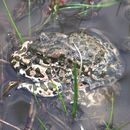en
names in breadcrumbs


Total length up to 10cm, usually less, rarely more. Females are bigger than males. Can be found in a variety of habitats, even at high altitudes or dry areas. Mainly nocturnal although it can also be seen by day, especially in spring. Feeds mainly on invertebrates. Mates very early in spring and females can lay a few thousand of eggs. If caught, and becomes overly stressed, it secretes defensive toxins from the parotoid glands. Although effective in preventing most predators, those toxins are harmless to humans when contact is made with the skin.